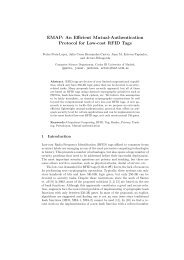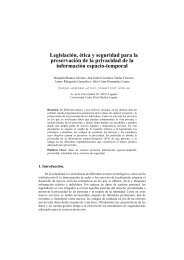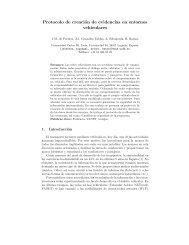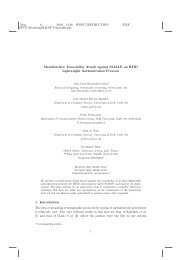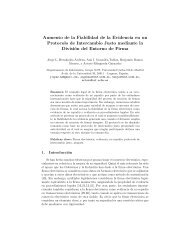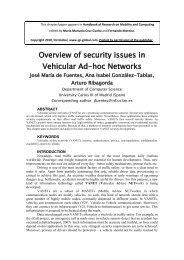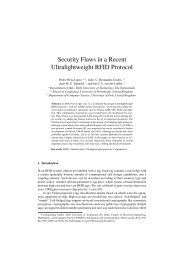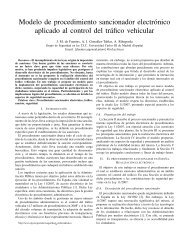N3: A Geometrical Approach for Network Intrusion Detection at the ...
N3: A Geometrical Approach for Network Intrusion Detection at the ...
N3: A Geometrical Approach for Network Intrusion Detection at the ...
You also want an ePaper? Increase the reach of your titles
YUMPU automatically turns print PDFs into web optimized ePapers that Google loves.
<strong>N3</strong>: A <strong>Geometrical</strong> <strong>Approach</strong> <strong>for</strong> <strong>Network</strong><br />
<strong>Intrusion</strong> <strong>Detection</strong> <strong>at</strong> <strong>the</strong> Applic<strong>at</strong>ion Layer<br />
Juan M. Estévez-Tapiador, Pedro García-Teodoro, and Jesús E. Díaz-Verdejo<br />
Research Group on Signals, Telem<strong>at</strong>ics and Communic<strong>at</strong>ions<br />
Department of Electronics and Computer Technology<br />
University of Granada<br />
{tapiador, pgteodor, jedv}@ugr.es<br />
Abstract. In this work, a novel approach <strong>for</strong> <strong>the</strong> purpose of anomalybased<br />
network intrusion detection <strong>at</strong> <strong>the</strong> applic<strong>at</strong>ion layer is presented.<br />
The problem of identifying anomalous payloads is addressed by using a<br />
technique based on <strong>the</strong> modelling of short sequences of adjoining bytes<br />
in <strong>the</strong> requests destined to a given service. Upon this <strong>the</strong>oretical framework,<br />
we propose an algorithm th<strong>at</strong> assigns an anomaly score to each<br />
service request on <strong>the</strong> basis of its similarity with a previously established<br />
model of normality. The introduced approach has been evalu<strong>at</strong>ed<br />
by considering d<strong>at</strong>asets composed of HTTP and DNS traffic. Thus, a<br />
large amount of <strong>at</strong>tacks rel<strong>at</strong>ed with such services has been g<strong>at</strong>hered,<br />
and detailed experimental results concerning <strong>the</strong> detection capability of<br />
<strong>the</strong> proposed system are shown. The experiments demonstr<strong>at</strong>e th<strong>at</strong> our<br />
approach yields a very high detection r<strong>at</strong>e with a low level of false alarms.<br />
1 Introduction<br />
As Carl Landwehr brilliantly indic<strong>at</strong>es in his introductory article to <strong>the</strong> field of<br />
computer security [1], several paradigms have configured <strong>the</strong> research scene in<br />
this area from <strong>the</strong> early days of modern computing to d<strong>at</strong>e. Wh<strong>at</strong> can be design<strong>at</strong>ed<br />
as <strong>the</strong> first gener<strong>at</strong>ion of security technologies defines a broad spectrum<br />
of defense techniques oriented to prevent <strong>the</strong> occurrence of successful intrusions<br />
or viol<strong>at</strong>ions of <strong>the</strong> security policy. Due to various reasons th<strong>at</strong> fall out of <strong>the</strong><br />
scope of this discussion, <strong>the</strong> security research community started to develop<br />
procedures and mechanisms intended to detect and limit <strong>at</strong>tacks th<strong>at</strong> are very<br />
difficult to prevent because of <strong>the</strong> n<strong>at</strong>ure of our current technologies. Firewalls<br />
and <strong>Intrusion</strong> <strong>Detection</strong> Systems (hence<strong>for</strong>th referred to as IDS) are surely <strong>the</strong><br />
maximum exponent of this paradigm. Nowadays, and although many relevant<br />
problems still remain unsolved within <strong>the</strong> two previous paradigms, intrusion<br />
tolerant schemes constitute a new and challenging research topic. Projects like<br />
OASIS (Organically Assured and Survivable In<strong>for</strong>m<strong>at</strong>ion System) [2] and MAF-<br />
TIA (Malicious-and Accidental-Fault Tolerance <strong>for</strong> Internet Applic<strong>at</strong>ions) [3],<br />
among o<strong>the</strong>rs, have developed concepts, architectures, and prototypes within<br />
<strong>the</strong> intrusion tolerance approach.<br />
A. Laganà et al. (Eds.): ICCSA 2004, LNCS 3043, pp. 841–850, 2004.<br />
c○ Springer-Verlag Berlin Heidelberg 2004
842 J.M. Estévez-Tapiador, P. García-Teodoro, and J.E. Díaz-Verdejo<br />
Even though a number of open problems still remain unsolved, research in<br />
IDS constitutes a rel<strong>at</strong>ively m<strong>at</strong>ure field. Interested readers can find good introductions<br />
to IDS in [4], [5], [6], and [7], among o<strong>the</strong>rs. The two key methodologies<br />
th<strong>at</strong> have traditionally been used to detect intrusions in network systems are<br />
rel<strong>at</strong>ed to how <strong>the</strong> collected d<strong>at</strong>a from <strong>the</strong> sensors are analyzed. In <strong>the</strong> so-called<br />
misuse-based detection, each known <strong>at</strong>tack is described through an specific p<strong>at</strong>tern,<br />
commonly referred to as its sign<strong>at</strong>ure, which identifies it without ambiguity.<br />
The core of <strong>the</strong> detection engine is basically a p<strong>at</strong>tern-m<strong>at</strong>ching algorithm, in<br />
such a way th<strong>at</strong> incoming activities th<strong>at</strong> m<strong>at</strong>ch a p<strong>at</strong>tern in <strong>the</strong> library of sign<strong>at</strong>ures<br />
cause an alarm raise. On <strong>the</strong> o<strong>the</strong>r hand, <strong>the</strong> basic principle supporting<br />
anomaly-based detection systems is <strong>the</strong> hypo<strong>the</strong>sis th<strong>at</strong> every anomalous event is<br />
suspicious from a security point of view. An event can be c<strong>at</strong>alogued as anomalous<br />
because its degree of devi<strong>at</strong>ion with respect to <strong>the</strong> profile of characteristic<br />
system behavior. Although current intrusion detection technology mainly relies<br />
on misuse detection mechanisms, anomaly detection has been typically conceived<br />
as a more powerful mechanism due to its <strong>the</strong>oretical potential <strong>for</strong> addressing<br />
novel or un<strong>for</strong>eseen <strong>at</strong>tacks.<br />
In this work, we deal with <strong>the</strong> problem of anomaly detection <strong>at</strong> <strong>the</strong> applic<strong>at</strong>ion<br />
layer <strong>for</strong> network-based IDS. A <strong>the</strong>oretical framework is introduced and<br />
applied to HTTP and DNS protocols. Section 2 serves to <strong>the</strong> purpose of presenting<br />
<strong>the</strong> core of <strong>the</strong> approach proposed in this work, which relies on <strong>the</strong><br />
modelling of short sequences of adjoining bytes in specific service requests. A<br />
detection algorithm based on this principle of oper<strong>at</strong>ion is <strong>the</strong>n introduced. The<br />
experimental results presented in Section 3 confirm th<strong>at</strong> short sequences are excellent<br />
fe<strong>at</strong>ures <strong>for</strong> distinguishing between normal requests and those containing<br />
several <strong>for</strong>ms of <strong>at</strong>tack. Finally, a per<strong>for</strong>mance analysis of <strong>the</strong> developed system<br />
is introduced in Section 4, and Section 5 concludes <strong>the</strong> paper summarizing <strong>the</strong><br />
benefits of <strong>the</strong> introduced work as well as future research objectives.<br />
2 <strong>N3</strong>: A <strong>Geometrical</strong> Method <strong>for</strong> <strong>Intrusion</strong> <strong>Detection</strong> <strong>at</strong><br />
<strong>the</strong> Applic<strong>at</strong>ion Layer<br />
As <strong>the</strong> vast majority of <strong>the</strong> proposals developed in <strong>the</strong> field of anomaly-based<br />
network IDS, <strong>the</strong> technique introduced in this article tries to model <strong>the</strong> network<br />
traffic with <strong>the</strong> aim of obtaining a represent<strong>at</strong>ion of normal behavior ([8], [9],<br />
[10], [11], [12]). In this case, <strong>the</strong> objects we intend to model within <strong>the</strong> proposed<br />
approach are applic<strong>at</strong>ion-level payloads from a number of traffic sources (clients),<br />
specifically those containing requests destined to a given service. In <strong>the</strong> case of<br />
HTTP, this applic<strong>at</strong>ion-layer protocol is defined by RFC 2068, albeit certain<br />
elements like URIs (Uni<strong>for</strong>m Resource Identifiers) are defined in o<strong>the</strong>r standard<br />
documents (RFC 2396 <strong>for</strong> <strong>the</strong> mentioned identifiers). In its basic <strong>for</strong>m, HTTP<br />
payloads are human-readable strings enclosing elements like <strong>the</strong> version of <strong>the</strong><br />
protocol, <strong>the</strong> identifier of <strong>the</strong> requested object, several parameters rel<strong>at</strong>ed to <strong>the</strong><br />
request, etc. As just exposed, some works in this field have established th<strong>at</strong>,<br />
due precisely to <strong>the</strong> n<strong>at</strong>ure of <strong>the</strong> contents transported by <strong>the</strong> protocol, HTTP
<strong>N3</strong>: A <strong>Geometrical</strong> <strong>Approach</strong> <strong>for</strong> <strong>Network</strong> <strong>Intrusion</strong> <strong>Detection</strong> 843<br />
requests destined to a server share a common structure, in such a way th<strong>at</strong> it<br />
is possible to measure certain degree of similarity among <strong>the</strong> normal payloads<br />
received by a given server.<br />
The analysis <strong>for</strong> <strong>the</strong> DNS system is similar. DNS queries and responses are<br />
carried in a standard message <strong>for</strong>m<strong>at</strong> (see Internet Standard 13 or, equivalently,<br />
RFC 1034). Each message is composed of a header with a number of fixed<br />
fields and four sections (Question, Answer, Authority, and Additional) containing<br />
query parameters and resource registers. Although <strong>the</strong> contents carried over<br />
this fixed <strong>for</strong>m<strong>at</strong> can vary according to <strong>the</strong> header options, <strong>the</strong>y always enclose a<br />
number of readable strings with values <strong>for</strong> <strong>the</strong> different fields. Interested readers<br />
can find in <strong>the</strong> above mentioned standard various examples th<strong>at</strong> illustr<strong>at</strong>e this<br />
fact in detail.<br />
In wh<strong>at</strong> follows, we introduce a <strong>for</strong>mal background intended to manipul<strong>at</strong>e<br />
and model <strong>the</strong> type of short sequences previously referred.<br />
2.1 Sequence Analysis<br />
Let Σ = {s 1 ,s 2 ,...,s n } be a finite set of size n, namely alphabet and composed<br />
by elements which we refer to as symbols. In this discussion, we shall assume th<strong>at</strong><br />
Σ is <strong>the</strong> ASCII code, in such a way th<strong>at</strong> |Σ| = 256. There<strong>for</strong>e, each complete<br />
payload (i.e., a transaction destined to a server) can be represented as an element<br />
p = s i1 s i2 s i3 ···s i|p| ∈ Σ ∗ , where Σ ∗ is <strong>the</strong> set of all possible sequences gener<strong>at</strong>ed<br />
by conc<strong>at</strong>en<strong>at</strong>ing a finite number of symbols inΣ.<br />
Since Σ is a finite set, it is possible to compute and enumer<strong>at</strong>e all <strong>the</strong> different<br />
sequences of a fixed length, k, th<strong>at</strong> can be gener<strong>at</strong>ed from it. To be precise, given<br />
th<strong>at</strong> |Σ| = n, <strong>the</strong>re are n k different sequences of length k, which can be ordered<br />
from 1 to n k . Once fixed a given order, we shall denote by σ i <strong>the</strong> i-th sequence.<br />
As st<strong>at</strong>ed, a payload p is easily conceived as a sequence of symbols. Let<br />
us consider <strong>the</strong> following trans<strong>for</strong>m<strong>at</strong>ion λ k , according to which each complete<br />
payload p is mapped to a n k -dimensional vector space, Θ k , as follows:<br />
λ k : Σ ∗ → Θ k<br />
λ k (p) =(t 1 ,t 2 ,...,t n k) (1)<br />
where each component of <strong>the</strong> image vector, t i , is <strong>the</strong> number of times th<strong>at</strong> <strong>the</strong><br />
sequence σ i , of length k, appears in <strong>the</strong> complete sequence p.<br />
Our objective is to measure similarities between payloads once trans<strong>for</strong>med<br />
into <strong>the</strong> new space of represent<strong>at</strong>ion. Since Θ k is a Hilbert space, <strong>for</strong> every pair<br />
of points x a =(t a 1,...,t a n<br />
),x k b =(t b 1,...,t b n<br />
) ∈ Θ k k , <strong>the</strong>ir dot product, denoted<br />
〈x a ,x b 〉, is defined. Given a dot product, we can also define <strong>the</strong> distance between<br />
two points x 1 ,x 2 ∈ Θ k as:<br />
(<br />
) 1<br />
2<br />
d(x 1 ,x 2 )=‖x 1 − x 2 ‖ = 〈x 1 ,x 1 〉−2〈x 1 ,x 2 〉 + 〈x 2 ,x 2 〉 (2)<br />
Likewise, given two payloads p 1 ,p 2 ∈ Σ ∗ , and a fixed k, we can define <strong>the</strong><br />
distance between <strong>the</strong>m as d(λ k (p 1 ),λ k (p 2 )). In many cases, it is comput<strong>at</strong>ionally<br />
very expensive to explicitly obtain <strong>the</strong> represent<strong>at</strong>ion exposed above <strong>for</strong>
844 J.M. Estévez-Tapiador, P. García-Teodoro, and J.E. Díaz-Verdejo<br />
each payload. For instance, <strong>the</strong> ASCII code contains 256 different symbols, and<br />
assuming th<strong>at</strong> we take short sequences of length k = 5, each payload is mapped<br />
to a vector of 256 5 = 1099511627776 components. We are interested, however,<br />
in <strong>the</strong> distances between payloads and, <strong>the</strong>re<strong>for</strong>e, in establishing a procedure <strong>for</strong><br />
computing <strong>the</strong>m without an explicit mapping of <strong>the</strong> payloads to <strong>the</strong>ir images.<br />
Fortun<strong>at</strong>ely, <strong>the</strong> field of algorithms on sequences is a rel<strong>at</strong>ively well-known<br />
and studied discipline. There exists a dynamic programming-based algorithm<br />
th<strong>at</strong> computes in O(n 2 ) oper<strong>at</strong>ions <strong>the</strong> number of subsequences of length k<br />
shared by two input sequences (where n is <strong>the</strong> length of <strong>the</strong> input sequences). The<br />
precise description of th<strong>at</strong> algorithm is out of <strong>the</strong> scope of this paper, although<br />
interested readers can found a deep description of it in [13]. In any case, note<br />
th<strong>at</strong>, by <strong>the</strong> very definition of λ k (p), it is easy to compute <strong>the</strong> dot products<br />
involved in <strong>the</strong> distance calcul<strong>at</strong>ion given by <strong>the</strong> expression (2) by using this<br />
algorithm.<br />
2.2 The <strong>N3</strong> Anomaly Detector<br />
The analysis of sequences presented allows us to develop a novel anomaly-based<br />
intrusion detection approach. For th<strong>at</strong>, let us make <strong>the</strong> following initial definitions.<br />
Definition 1. A m<strong>at</strong>hem<strong>at</strong>ical model of an applic<strong>at</strong>ion-layer protocol L, denoted<br />
M L , is defined as a represent<strong>at</strong>ive set of <strong>the</strong> normal payloads of such a<br />
protocol; th<strong>at</strong> is, M L = {p 1 ,p 2 ,...,p N }<br />
Definition 2. The distance from a payload p to a model of <strong>the</strong> corresponding<br />
service, denoted D(p, M L ), is defined as <strong>the</strong> distance from p to its nearest<br />
neighbor element in <strong>the</strong> model, using <strong>for</strong> this purpose <strong>the</strong> similarity function d<br />
defined in expression (2). This distance will be termed <strong>the</strong> anomaly score of<br />
<strong>the</strong> payload p, denoted A s (p).<br />
Considering <strong>the</strong>se definitions, it is possible to construct an anomaly detector<br />
based on <strong>the</strong> distance within <strong>the</strong> context of <strong>the</strong> introduced framework. Thus,<br />
assuming th<strong>at</strong> <strong>the</strong> model of normal behavior is given by <strong>the</strong> set M L of normal<br />
payloads observed <strong>for</strong> <strong>the</strong> selected service, deciding whe<strong>the</strong>r a captured payload,<br />
p, is labelled as anomalous or not is per<strong>for</strong>med by calcul<strong>at</strong>ing its anomaly score:<br />
A s (p) =D(p, M L ) = min d(p, m) (3)<br />
∀m∈M L<br />
Once computed <strong>the</strong> previous score, <strong>the</strong> detection rule is straight<strong>for</strong>ward:<br />
<strong>Detection</strong> Rule: A payload p is design<strong>at</strong>ed as anomalous if A s (p) ≥ θ,<br />
where θ is a threshold which acts as a tuning parameter.<br />
Since <strong>the</strong> model of applic<strong>at</strong>ion-layer traffic is exclusively composed of normal<br />
payloads, we will refer to this detection algorithm as Nearest Normal Neighbor<br />
(<strong>N3</strong> <strong>for</strong> shorthand). The essence of <strong>the</strong> detection procedure allows us to design<strong>at</strong>e<br />
this technique as a geometrical method.
<strong>N3</strong>: A <strong>Geometrical</strong> <strong>Approach</strong> <strong>for</strong> <strong>Network</strong> <strong>Intrusion</strong> <strong>Detection</strong> 845<br />
Table 1. Test-bed of normal and <strong>at</strong>tack traffic used <strong>for</strong> <strong>the</strong> evalu<strong>at</strong>ion.<br />
D<strong>at</strong>aset In<strong>for</strong>m<strong>at</strong>ion Size (No. of service requests)<br />
Protocol Class Total Distinct Training Test<br />
HTTP Normal, host hume 12154 2271 1590 681<br />
HTTP Normal, host marx 16539 2388 1672 716<br />
HTTP Attack 1500 119 – 119<br />
DNS Normal 193083 66783 46849 19934<br />
DNS Attack 6 6 – 6<br />
3 Experimental Results<br />
In order to evalu<strong>at</strong>e <strong>the</strong> detection capabilities of <strong>the</strong> proposed method <strong>N3</strong>, several<br />
experiments have been carried out. The evalu<strong>at</strong>ion framework considered and <strong>the</strong><br />
results obtained are discussed in this section.<br />
3.1 Test-Bed of HTTP and DNS Traffic<br />
An important aspect of any evalu<strong>at</strong>ion process is <strong>the</strong> d<strong>at</strong>aset to use. The DARPA<br />
1999 IDS Evalu<strong>at</strong>ion Program [14] has been considered in this work <strong>for</strong> this<br />
purpose. Although it is not free of drawbacks (see [15] <strong>for</strong> an excellent critique), it<br />
is undeniable th<strong>at</strong> this has been <strong>the</strong> only remarkable ef<strong>for</strong>t to provide a public and<br />
common facility <strong>for</strong> <strong>the</strong> evalu<strong>at</strong>ion of IDSs. The framework is basically composed<br />
of several off-line test sets, each one consisting of traffic captured during 5 weeks<br />
on a network with hundreds of hosts and a connection to Internet. The training<br />
d<strong>at</strong>a consists of <strong>the</strong> first 3 weeks, while <strong>the</strong> remaining 2 weeks constitute test<br />
traffic.<br />
In our approach of tackling <strong>the</strong> problem of anomaly detection <strong>at</strong> <strong>the</strong> applic<strong>at</strong>ion<br />
layer, complete d<strong>at</strong>a sets of both normal traffic and anomalous connections<br />
are required. We have collected normal traffic from <strong>the</strong> DARPA’99 IDS Evalu<strong>at</strong>ion<br />
d<strong>at</strong>a sets, specifically from weeks 1 and 3, which are <strong>at</strong>tack-free. Since our<br />
purpose is studying HTTP and DNS traffic, we have extracted packets destined<br />
to two different servers: hume (NT Server with IP address 172.16.112.100) and<br />
marx (Linux Server with IP address 172.16.114.50). The total amount of requests<br />
extracted and reassembled, if needed, has been 12154 <strong>for</strong> hume and 16539<br />
<strong>for</strong> marx. Please note th<strong>at</strong> <strong>the</strong>re is a large amount of redundancy within <strong>the</strong><br />
d<strong>at</strong>a, i.e. <strong>the</strong> same request origin<strong>at</strong>ed from distinct clients. Table 1 summarizes<br />
<strong>the</strong> most important in<strong>for</strong>m<strong>at</strong>ion concerning <strong>the</strong>se d<strong>at</strong>asets. In <strong>the</strong> case of DNS<br />
traffic, <strong>the</strong> g<strong>at</strong>hering task has been similar to th<strong>at</strong> just described <strong>for</strong> HTTP. A<br />
total amount of 193083 requests have been extracted from <strong>the</strong> traffic files. After<br />
processing <strong>the</strong>m with <strong>the</strong> aim of removing duplic<strong>at</strong>e elements, <strong>the</strong> useful d<strong>at</strong>aset<br />
is composed of 66783 different service payloads.<br />
Additionally, we have collected several well-known vulnerabilities in <strong>the</strong><br />
HTTP and DNS services. The <strong>at</strong>tack d<strong>at</strong>asets used include several variants of<br />
86 HTTP exploits based on vulnerabilities listed in arachNIDS d<strong>at</strong>abase [16].
846 J.M. Estévez-Tapiador, P. García-Teodoro, and J.E. Díaz-Verdejo<br />
Table 2. Attacks against <strong>the</strong> DNS service used in <strong>the</strong> experiment<strong>at</strong>ion.<br />
ID Attack name C<strong>at</strong>egory ArachNIDS Ref.<br />
A1 DNS PROBE-IQUERY<br />
In<strong>for</strong>m<strong>at</strong>ion G<strong>at</strong>hering Ref. IDS277<br />
A2 DNS EXPLOIT-TSIG-LSD System Integrity Ref. IDS489<br />
A3 DNS EXPLOIT-TSIG-LUCYSOFT System Integrity Ref. IDS490<br />
A4 DNS EXPLOIT-TSIG-LUCYSOFT2 System Integrity Ref. IDS490<br />
A5 DNS EXPOIT-TSIG-TSIG0WN System Integrity Ref. IDS491<br />
A6 DNS EXPLOIT-INFOLEAK-LSD System Integrity Ref. IDS482<br />
Attack payloads are gener<strong>at</strong>ed by means of programs th<strong>at</strong> implement <strong>the</strong> corresponding<br />
exploit <strong>for</strong> each <strong>at</strong>tack. For evalu<strong>at</strong>ion purposes, a total amount of<br />
1500 malicious payloads were gener<strong>at</strong>ed, captured and recorded in <strong>the</strong> same way<br />
th<strong>at</strong> was done <strong>for</strong> normal traffic. The number of known <strong>at</strong>tacks against <strong>the</strong> DNS<br />
system is more reduced. Table 2 lists <strong>the</strong> 6 <strong>at</strong>tacks against a name server th<strong>at</strong><br />
have been used in this work.<br />
3.2 Evalu<strong>at</strong>ion and <strong>Detection</strong> Results<br />
With <strong>the</strong> aim of evalu<strong>at</strong>ing <strong>the</strong> introduced <strong>N3</strong> approach, we have per<strong>for</strong>med <strong>the</strong><br />
following experiments. Given a specific protocol L (HTTP or DNS), <strong>the</strong> total<br />
amount of normal traffic available is divided into two subsets. The first of <strong>the</strong>m,<br />
denoted M L as st<strong>at</strong>ed in Section 2.1, is composed of 70% of randomly chosen<br />
payloads and constitutes <strong>the</strong> model of normality. The remaining 30% is devoted<br />
to a different subset, namely N L , <strong>for</strong> evalu<strong>at</strong>ion purposes. Our experimental<br />
scenario is thus composed of three sets of payloads <strong>for</strong> each protocol:<br />
• The models, M HTTP and M DNS , of normal traffic <strong>for</strong> each protocol.<br />
•N HTTP and N DNS , containing payloads of normal traffic <strong>for</strong> each protocol.<br />
These will be used <strong>for</strong> <strong>the</strong> evalu<strong>at</strong>ion of <strong>the</strong> detection per<strong>for</strong>mance.<br />
•A HTTP and A DNS , containing <strong>the</strong> d<strong>at</strong>asets of <strong>at</strong>tack traffic described in<br />
Section 3.1. These will be used <strong>for</strong> <strong>the</strong> evalu<strong>at</strong>ion, toge<strong>the</strong>r with <strong>the</strong> d<strong>at</strong>asets<br />
of normal traffic.<br />
For each payload p in <strong>the</strong> d<strong>at</strong>asets used <strong>for</strong> <strong>the</strong> evalu<strong>at</strong>ion, <strong>the</strong> anomaly<br />
score A s (p) is computed by using <strong>the</strong> <strong>N3</strong> algorithm. The key results of this<br />
experiment <strong>for</strong> <strong>the</strong> HTTP protocol are graphically shown in Fig. 1 <strong>for</strong> different<br />
values of <strong>the</strong> parameter k involved in <strong>the</strong> distance comput<strong>at</strong>ion (short-sequence<br />
length). In order to distinguish between normal and anomalous traffic, some<br />
parameters rel<strong>at</strong>ed to <strong>the</strong> frontiers of each region in <strong>the</strong> decision surface are of <strong>the</strong><br />
utmost importance. With <strong>the</strong> aim of illustr<strong>at</strong>ing this fact, <strong>the</strong> mentioned figure<br />
shows <strong>the</strong> range (minimum and maximum) and <strong>the</strong> average distance among<br />
all <strong>the</strong> evalu<strong>at</strong>ed payloads. For instance, in <strong>the</strong> case of HTTP payloads and<br />
using a length k = 8, normal payloads present an anomaly score within <strong>the</strong><br />
interval [3.464, 11.533], with an average value of 6.496. On <strong>the</strong> o<strong>the</strong>r hand, <strong>at</strong>tack
<strong>N3</strong>: A <strong>Geometrical</strong> <strong>Approach</strong> <strong>for</strong> <strong>Network</strong> <strong>Intrusion</strong> <strong>Detection</strong> 847<br />
Fig. 1. Ranges and average value corresponding to <strong>the</strong> distance from each evalu<strong>at</strong>ed<br />
HTTP payload within <strong>the</strong> test d<strong>at</strong>a set to its nearest neighbor in <strong>the</strong> model. For<br />
each value of <strong>the</strong> window length k, <strong>the</strong> minimum, maximum and average distances are<br />
represented <strong>for</strong> normal traffic. In <strong>the</strong> case of <strong>at</strong>tacks, however, only <strong>the</strong> minimum is<br />
shown due to limit problems (average values are around 270 and maximums around<br />
1500).<br />
payloads obtain scores within <strong>the</strong> interval [13.229, 1501.232], with an average<br />
value of 263.472.<br />
It is easily observed a clear separ<strong>at</strong>ion between both types of traffic <strong>for</strong> values<br />
in <strong>the</strong> range 2 ≤ k ≤ 17, reaching <strong>the</strong> maximum difference <strong>at</strong> k = 5. For <strong>the</strong>se<br />
values of k, it would be possible to distinguish payloads carrying an <strong>at</strong>tack<br />
from normal traffic with potentially no false alarms. Considering <strong>the</strong>se results,<br />
a threshold θ ≃ 12 <strong>for</strong> k = 5 seems adequ<strong>at</strong>e <strong>for</strong> an accur<strong>at</strong>e detection. To be<br />
precise, <strong>for</strong> values of k ∈ [2, 17], all <strong>the</strong> <strong>at</strong>tacks considered during <strong>the</strong> evalu<strong>at</strong>ion<br />
were successfully detected without false alarms.<br />
This is not, however, <strong>the</strong> case <strong>for</strong> DNS traffic, in which some overlapping<br />
exists between both regions. For instance, <strong>the</strong> anomaly score <strong>for</strong> normal DNS<br />
payloads ranges between 1.414 and 16.912 <strong>for</strong> a value of k = 5, with an average<br />
value of 2.034. The following table shows <strong>the</strong> anomaly score (A s ) obtained<br />
by each of <strong>the</strong> six <strong>at</strong>tacks used in <strong>the</strong> evalu<strong>at</strong>ion with <strong>the</strong> same value of <strong>the</strong><br />
parameter k:<br />
Attack A1 DNS A2 DNS A3 DNS A4 DNS A5 DNS A6 DNS<br />
A s 4.472 35.972 41.061 28.775 254.790 4.000<br />
According to this, it is clearly observed th<strong>at</strong> <strong>at</strong>tacks A1 DNS and A6 DNS are<br />
not correctly classified as anomalous, whilst <strong>the</strong> remainder four <strong>at</strong>tacks yield<br />
anomaly scores easily recognizable as unusual. A brief analysis of <strong>the</strong> n<strong>at</strong>ure of
848 J.M. Estévez-Tapiador, P. García-Teodoro, and J.E. Díaz-Verdejo<br />
<strong>the</strong>se two <strong>at</strong>tacks reveals <strong>the</strong> cause <strong>for</strong> such an unsuccessful detection. In <strong>the</strong><br />
case of A1 DNS (usually known as PROBE-IQUERY), it is basically a request<br />
<strong>at</strong>tempting to determine if a name server supports inverse queries. Even though<br />
this action constitutes a usual pre-<strong>at</strong>tack probe and, hence, it should be restricted<br />
by <strong>the</strong> site security policy, it does not involve elements th<strong>at</strong> can be design<strong>at</strong>ed<br />
as out of <strong>the</strong> ordinary. A similar r<strong>at</strong>ionale can be provided <strong>for</strong> <strong>the</strong> A6 DNS <strong>at</strong>tack<br />
(EXPLOIT-INFOLEAK-LSD).<br />
4 Per<strong>for</strong>mance Consider<strong>at</strong>ions and Improvements<br />
The detection process is per<strong>for</strong>med through a nearest neighbor (NN) search and<br />
a subsequent comparison with an established threshold. Since <strong>the</strong> comput<strong>at</strong>ion<br />
of each of <strong>the</strong> N required distances (one per p<strong>at</strong>tern in <strong>the</strong> model) involves O(n 2 )<br />
oper<strong>at</strong>ions, <strong>the</strong> time required to decide whe<strong>the</strong>r a given payload is anomalous or<br />
not can be approxim<strong>at</strong>ed by <strong>the</strong> following expression:<br />
t <strong>Detection</strong> ≈C·τ(n 2 ) · N (4)<br />
where C is a constant factor th<strong>at</strong> includes fur<strong>the</strong>r oper<strong>at</strong>ions involved in <strong>the</strong><br />
decision as well as implement<strong>at</strong>ion-dependant details.<br />
According to Table 1, <strong>the</strong> model sizes have been, respectively, N = 3262<br />
payloads <strong>for</strong> HTTP traffic, and N = 46849 <strong>for</strong> DNS. Concerning <strong>the</strong> factor<br />
corresponding to <strong>the</strong> distance algorithm, <strong>the</strong> time required to carry out <strong>the</strong><br />
comput<strong>at</strong>ion has been estim<strong>at</strong>ed during <strong>the</strong> experiments in a computer with a<br />
Pentium 4 processor <strong>at</strong> 2.4 GHz with 1 GB of RAM. The obtained times, which<br />
obviously depend on <strong>the</strong> length of <strong>the</strong> input payloads, range between 0.000298<br />
ms <strong>for</strong> shorter requests and 0.0579 ms <strong>for</strong> <strong>the</strong> largest, with an average value of<br />
0.00483 ms.<br />
Taking into consider<strong>at</strong>ion <strong>the</strong> average value, it is possible to derive an approxim<strong>at</strong>ion<br />
<strong>for</strong> <strong>the</strong> number of service requests per second th<strong>at</strong> is possible to<br />
process under <strong>the</strong>se conditions. In <strong>the</strong> case of HTTP with <strong>the</strong> current model,<br />
<strong>the</strong> average time required <strong>for</strong> reaching a decision about <strong>the</strong> anomalous n<strong>at</strong>ure<br />
of a request is t <strong>Detection</strong> =0.00483 · 3262 = 15.76 ms. This value implies th<strong>at</strong>,<br />
in a computer similar to th<strong>at</strong> used in our labor<strong>at</strong>ory, <strong>the</strong> system will be able to<br />
process around 63 HTTP requests per second. In <strong>the</strong> case of DNS, this value<br />
is around 5 requests per second. Considering <strong>the</strong> typical load of a server, <strong>the</strong>se<br />
results could sternly limit <strong>the</strong> applic<strong>at</strong>ion in a real-time environment. Despite<br />
this undeniable fact, it is necessary to remember th<strong>at</strong> most of <strong>the</strong> currently proposed<br />
anomaly methods involve detection mechanisms much more complex and<br />
inefficient than th<strong>at</strong> exposed here.<br />
As established in expression (4), <strong>the</strong> two major factors involved in <strong>the</strong> system<br />
oper<strong>at</strong>ion and capable of being improved are <strong>the</strong> distance comput<strong>at</strong>ion algorithm<br />
and <strong>the</strong> model size (i.e., <strong>the</strong> number of prototypes th<strong>at</strong> define <strong>the</strong> notion of normal<br />
traffic). The second of <strong>the</strong>m could be easily reduced by means of a clustering<br />
algorithm. In this sense, we have obtained some preliminary results through <strong>the</strong><br />
applic<strong>at</strong>ion of a k − means-like procedure to <strong>the</strong> HTTP and DNS models used
<strong>N3</strong>: A <strong>Geometrical</strong> <strong>Approach</strong> <strong>for</strong> <strong>Network</strong> <strong>Intrusion</strong> <strong>Detection</strong> 849<br />
in Section 3. Although a complete discussion is not shown here due to space<br />
reasons, in both cases a reduction in <strong>the</strong> number of prototypes up to 98% has<br />
been obtained without affecting <strong>the</strong> detection capabilities. Thus, considering a<br />
reduced model composed of 25 HTTP prototypes and using <strong>the</strong> same time values<br />
<strong>for</strong> distance processing provided below, <strong>the</strong> detection time is reduced from <strong>the</strong><br />
original t <strong>Detection</strong> =15.76 ms to t <strong>Detection</strong> =0.00483 · 25=0.121 ms. With this<br />
value, <strong>the</strong> detector can handle around 8264 requests per second, which clearly<br />
outper<strong>for</strong>ms <strong>the</strong> 63 requests per second of <strong>the</strong> original model. In <strong>the</strong> case of<br />
DNS, this improvement is still higher: With a model of N p = 107 prototypes,<br />
<strong>the</strong> system can handle around 1937 requests per second, in contrast with <strong>the</strong><br />
limited 5 requests per second corresponding to <strong>the</strong> original complete model.<br />
5 Conclusions and Future Work<br />
In this article, a new approach <strong>for</strong> detecting anomalies in network traffic <strong>at</strong> <strong>the</strong><br />
applic<strong>at</strong>ion layer has been presented, toge<strong>the</strong>r with some experimental results<br />
th<strong>at</strong> confirm its efficacy. The proposed method has been applied to HTTP and<br />
DNS traffic, and it models each service request, p, through its structural components<br />
provided by mapping it to a defined fe<strong>at</strong>ure space Θ k . Due to <strong>the</strong> very<br />
n<strong>at</strong>ure of <strong>the</strong> <strong>at</strong>tacks <strong>at</strong> <strong>the</strong> applic<strong>at</strong>ion layer, <strong>the</strong> introduced distance function<br />
seems to separ<strong>at</strong>e accur<strong>at</strong>ely between normal and anomalous payloads, allowing<br />
thus to detect suspicious traffic. Despite <strong>the</strong> undoubted benefits of <strong>the</strong> introduced<br />
work, <strong>the</strong>re exist a number of fe<strong>at</strong>ures th<strong>at</strong> can be improved in order to<br />
construct more efficient and effective detection devices based on <strong>the</strong> proposed<br />
technique.<br />
An important objective is th<strong>at</strong> of reducing <strong>the</strong> comput<strong>at</strong>ional complexity of<br />
<strong>the</strong> algorithms involved in <strong>the</strong> distance calcul<strong>at</strong>ion. As st<strong>at</strong>ed in <strong>the</strong> previous<br />
discussion, this is currently a limiting factor in <strong>the</strong> detection per<strong>for</strong>mance. On<br />
<strong>the</strong> o<strong>the</strong>r hand, <strong>the</strong>re exist more efficient algorithms <strong>for</strong> per<strong>for</strong>ming <strong>the</strong> NN<br />
search than th<strong>at</strong> used during our experiments, which can be used in a real<br />
applic<strong>at</strong>ion. Likewise, <strong>the</strong> use of altern<strong>at</strong>ive, and perhaps more sophistic<strong>at</strong>ed<br />
distances can yield better results than those obtained in our experiment<strong>at</strong>ion<br />
and exposed in this article. By using <strong>the</strong> proposed framework as a basis, one of<br />
<strong>the</strong> most promising research lines is th<strong>at</strong> of developing less coarse models th<strong>at</strong><br />
make use of <strong>the</strong> knowledge provided by <strong>the</strong> well-known message <strong>for</strong>m<strong>at</strong>s. We<br />
firmly believe th<strong>at</strong> <strong>the</strong> inclusion of protocol-dependant in<strong>for</strong>m<strong>at</strong>ion of a semantic<br />
n<strong>at</strong>ure, coupled with <strong>the</strong> use of more complex algorithms on sequences, will<br />
provide enhanced detection mechanisms.<br />
Acknowledgements. This work has been partially supported by <strong>the</strong> Spanish<br />
Government through MECD (N<strong>at</strong>ional Program PNFPU, reference AP2001-<br />
3805) and MCYT (project SERVIRA, TIC2002-02798, FEDER funds 70%).
850 J.M. Estévez-Tapiador, P. García-Teodoro, and J.E. Díaz-Verdejo<br />
References<br />
1. Landwehr, C.E. “Computer Security”, in Intern<strong>at</strong>ional Journal on In<strong>for</strong>m<strong>at</strong>ion<br />
Security, Vol. 1, No. 1, 2001, pp. 3–13.<br />
2. Project OASIS: Organically Assured and Survivable In<strong>for</strong>m<strong>at</strong>ion System. Available<br />
online <strong>at</strong>: http://www.tolerantsystems.org/<br />
3. Project MAFTIA: Malicious and Accidental Fault Tolerance <strong>for</strong> Internet Applic<strong>at</strong>ions.<br />
Available online <strong>at</strong>:<br />
http://www.newcastle.research.ec.org/maftia/index.html<br />
4. McHugh, J., “<strong>Intrusion</strong> and <strong>Intrusion</strong> <strong>Detection</strong>”, in Intern<strong>at</strong>ional Journal on In<strong>for</strong>m<strong>at</strong>ion<br />
Security, Vol. 1, No. 1, , 2001, pp. 14–35.<br />
5. Kemmerer, R.A. and Vigna, G., “<strong>Intrusion</strong> <strong>Detection</strong>: A Brief History and<br />
Overview”, in IEEE Computer, Vol. 35, Issue 4, April 2002, pp. 27–30.<br />
6. Allen, J., Christie, A., Fi<strong>the</strong>n, W., McHugh, J., Pickel, J., and Stoner, E. “St<strong>at</strong>e<br />
of <strong>the</strong> Practice of <strong>Intrusion</strong> <strong>Detection</strong> Technologies”. Technical Report CMU/SEI-<br />
99-TR-028, Software Engineering Institute, Carnegie Mellon, January 2000.<br />
7. Axelsson, S. “<strong>Intrusion</strong> <strong>Detection</strong> Systems: A Survey and Taxonomy”. Technical<br />
Report 99-15, Department of Computer Engineering, Chalmers University of Technology,<br />
Goteborg.<br />
8. Krügel, C., Toth, T., and Kirda, E. “Service Specific Anomaly <strong>Detection</strong> <strong>for</strong> <strong>Network</strong><br />
<strong>Intrusion</strong> <strong>Detection</strong>”, in Proceedings of <strong>the</strong> 17th ACM Symposium on Applied<br />
Computing (SAC), pp. 201–208, Madrid (Spain), 2002.<br />
9. Mahoney, M.V. and Chan, P.K., “Learning Nonst<strong>at</strong>ionary Models of Normal <strong>Network</strong><br />
Traffic <strong>for</strong> Detecting Novel Attacks”, in Proceedings of <strong>the</strong> 8th Intern<strong>at</strong>ional<br />
Conference on Knowledge Discovery and D<strong>at</strong>a Mining, 2002, pp. 376–385.<br />
10. Mahoney, M.V. and Chan, P.K., “An Analysis of <strong>the</strong> 1999 DARPA/Lincoln Labor<strong>at</strong>ory<br />
Evalu<strong>at</strong>ion D<strong>at</strong>a <strong>for</strong> <strong>Network</strong> Anomaly <strong>Detection</strong>”. Florida Institute of<br />
Technology Technical Report CS-2003-02, 2003.<br />
11. Mahoney, M.V., “<strong>Network</strong> Traffic Anomaly <strong>Detection</strong> Based on Packet Bytes”,<br />
in Proceedings of <strong>the</strong> 18th ACM Symposium on Applied Computing (SAC), Melbourne,<br />
FL (USA), 2003, pp. 346–350.<br />
12. Estevez-Tapiador, J.M., Garcia-Teodoro, P., Diaz-Verdejo, J.E., “Stochastic Protocol<br />
Modeling <strong>for</strong> Anomaly-Based <strong>Network</strong> <strong>Intrusion</strong> <strong>Detection</strong>”, in Proceedings<br />
of <strong>the</strong> 1st IEEE Intern<strong>at</strong>ional Workshop on In<strong>for</strong>m<strong>at</strong>ion Assurance (IWIA’03),<br />
Darmstadt (Germany), March 2003, pp. 3–12.<br />
13. Gusfield, D., Algorithms on Strings, Trees, and Sequences: Computer Science and<br />
Comput<strong>at</strong>ional Biology, ISBN: 0521585198, Cambridge University Press, 1997.<br />
14. Lippmann, R. Haines, J. W., Fried, D. J., Corba, J., and Das, K.: “The 1999<br />
DARPA Off-line <strong>Intrusion</strong> <strong>Detection</strong> Evalu<strong>at</strong>ion”, in Computer <strong>Network</strong>s, Vol. 34,<br />
No. 4, 2000, pp. 579–595.<br />
15. McHugh, J., “Testing <strong>Intrusion</strong> <strong>Detection</strong> Systems: A Critique to <strong>the</strong> 1998 and 1999<br />
DARPA <strong>Intrusion</strong> <strong>Detection</strong> Evalu<strong>at</strong>ions as Per<strong>for</strong>med by Lincoln Labor<strong>at</strong>ory”, in<br />
ACM Transactions on In<strong>for</strong>m<strong>at</strong>ion and Systems Security, Vol. 3. No. 4, November<br />
2000, pp. 262–294.<br />
16. arachNIDS: Advanced Reference Archive of Current Heuristics <strong>for</strong> <strong>Network</strong> <strong>Intrusion</strong><br />
<strong>Detection</strong> Systems. Available online <strong>at</strong>: http://www.whiteh<strong>at</strong>s.com/ids



